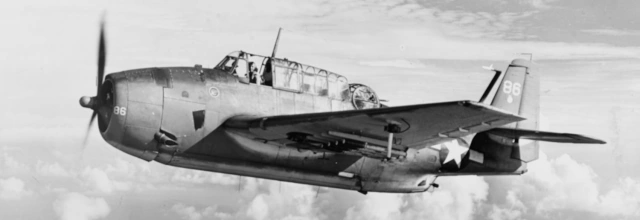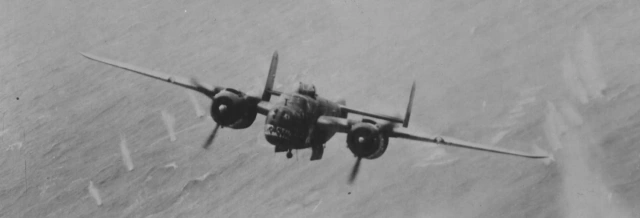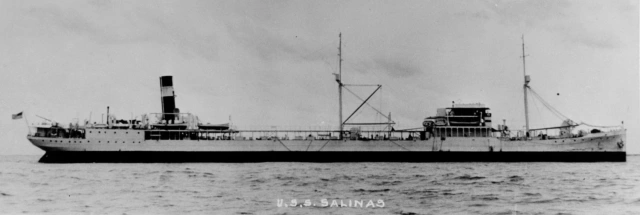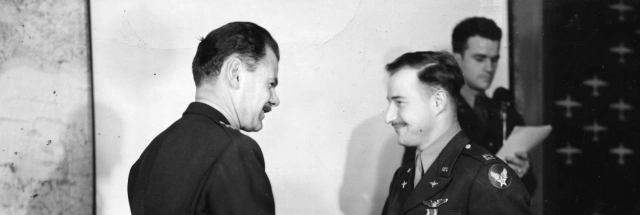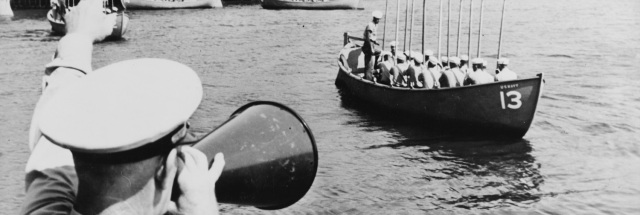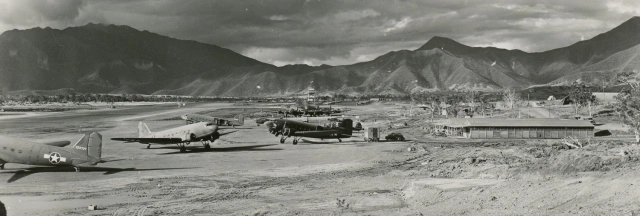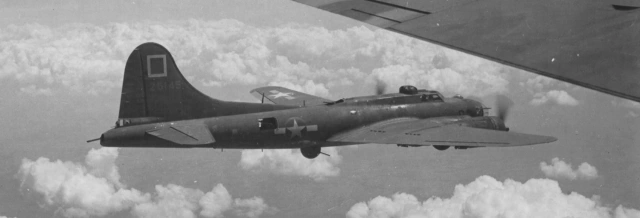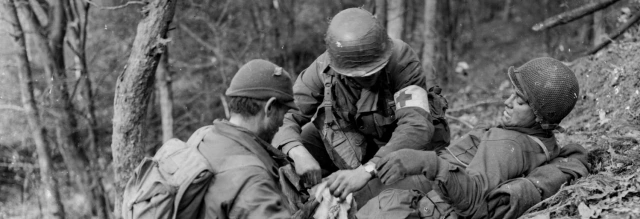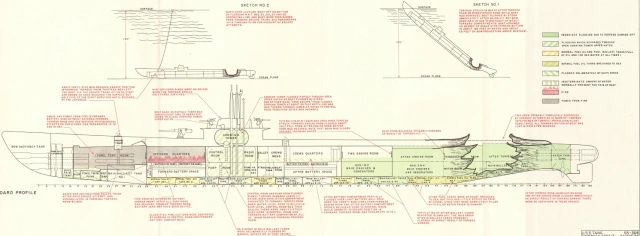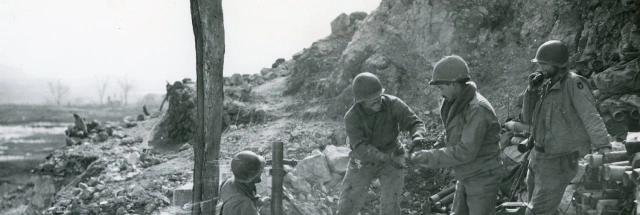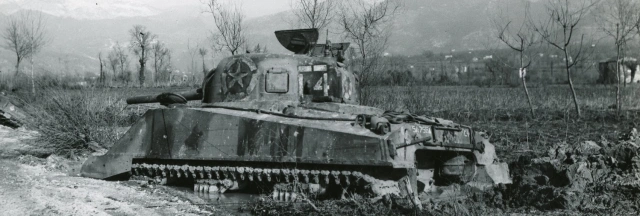
| Residences | Occupation |
| Alabama, Florida | Career soldier |
| Branch | Service Number |
| U.S. Army | 7006719 |
| Theater | Unit |
| Mediterranean | Company “C,” 894th Tank Destroyer Battalion |
| Awards | Campaigns/Battles |
| Purple Heart | Tunisian campaign, Italy (including Cassino and Anzio) |
Author’s note: Delaware’s World War II Fallen occasionally highlights men and women without any known connection to the First State. This article is part of a series on men of the 894th Tank Destroyer Battalion.
Early Life & Family
Frank Dixon was born in Alabama on April 21, 1917. He was the son of Frank Dixon (James Frank Dixon in some sources, a farmer, 1884–1936) and Gracie Caylor Dixon (1895–1998). He grew up in Covington County, Alabama. It appears that he was the eldest of six children.
The Dixon family was recorded on the census on March 19, 1920, living on Bradley Dann Road in Precinct 10, Covington County, Alabama. The family was recorded on the next census on April 23–24, 1930, with their address listed this time as being along the Bradley to Rome Road in Precinct 10, Covington County.
Census records indicate that by April 1, 1935, Dixon had moved one county south to DeFuniak Springs in Walton County, Florida. His father died the following year on August 27, 1936. Dixon’s name later appeared on a World War II casualty list for Okaloosa County, Florida, one county west of Walton, suggesting he enlisted there. Indeed, his mother lived in Laurel Hill, Okaloosa County, during the war.
According to paperwork in Dixon’s Individual Deceased Personnel File (I.D.P.F.), he stood five feet, eight inches tall and weighed 130 lbs., with red hair and blue eyes, and wore size 7-E shoes. Dixon was Protestant. According to a statement by his mother, Dixon was unmarried and had no children.
Military Career
Dixon volunteered for the Regular Army prior to the U.S. entry into World War II. It appears that he went on active duty at Fort Benning, Georgia, on January 15, 1940, and was assigned to the Field Artillery branch. Private Dixon was recorded on the census on April 12, 1940, living in barracks at Fort Benning. He was listed as a member of the 4th Anti-Tank Battalion.
The 4th Anti-Tank Battalion was activated at Fort Benning on January 1, 1940, just a few months before Dixon joined the U.S. Army. Originally armed with .50 machine guns, the unit soon reequipped with towed 37 mm antitank guns. Around June 1, 1940, the unit was redesignated as the 94th Anti-Tank Battalion, and as the 894th Tank Destroyer Battalion on December 15, 1941.
By December 25, 1941, Dixon had been promoted to sergeant and was a member of Company “C,” 894th Tank Destroyer Battalion at Fort Benning. On that date, his name appeared on a roster accompanying a Christmas dinner program. He was promoted to staff sergeant on February 1, 1942.

The 894th Tank Destroyer Battalion shipped out from the New York Port of Embarkation on August 6, 1942. The unit arrived in Liverpool on August 17, 1942. The unit shipped out from that same port on January 8, 1943, arriving in Algeria on January 16 or 17, 1943.
The men of the 894th first saw combat at the Battle of Kasserine Pass during the Tunisian campaign in February 1943. After the Tunisian campaign, the unit moved to the Fifth Army Tank Destroyer Training Center outside Sebdou, Algeria. During the summer of 1943, the unit reequipped from the M3 Gun Motor Carriage to the 3-inch Gun Motor Carriage M10. That fall, the 894th shipped out to Italy.
Unit morning reports indicate that Staff Sergeant Dixon was with the main body of Company “C,” which shipped out on November 2, 1943, aboard the S.S. Kościuszko, arriving in Italy on November 10, 1943. After performing military police duties in Naples, the 894th Tank Destroyer Battalion briefly returned to combat near Cassino before being withdrawn in preparation for the amphibious operation at Anzio.
Combat at Anzio
The 894th Tank Destroyer Battalion arrived at the Anzio beachhead in late January 1944 and was ordered to support the British 1st Infantry Division. By this time, Staff Sergeant Dixon was most likely platoon sergeant in 1st Platoon, Company “C.” According to a document in Dixon’s I.D.P.F., Company “C” was supporting the British 24th Infantry Brigade (Guards) during an advance to the rail line north of Aprilia.

In his book, The Tank Killers: A History of America’s World War II Tank Destroyer Force, Harry Yeide wrote that on the morning of January 30, 1944, Staff Sergeant Dixon joined
a patrol of fifteen British riflemen to scout for gun positions that the TDs could use during the day’s planned advance. German troops spotted the patrol, opened fire, and killed every man except for Dixon and a British sergeant. The two men crawled forward and shot the crew of a German machine gun. When another MG opened up and killed the British sergeant, Dixon fell to the ground and pretended to be dead. A German soldier approached and fired his pistol into the ground beside Dixon. Satisfied, he took the American sergeant’s helmet, carbine, and pipe. Dixon lay still for forty-five minutes while German soldiers stood nearby talking. Finally, he saw his chance and crawled back to his M10.
Staff Sergeant Dixon’s reprieve was brief. Yeide continued:
The advance kicked off […] when TDs carrying Tommies from the Irish Guards moved out. The M10s provided close support and engaged infantry and panzers that were carefully camouflaged and hard to spot beyond nearly point-blank range. One M10 KO’d a Volkswagen by driving over it. About 1530 hours, a hidden AT [antitank] gun put four rounds through both sides of Sergeant Dixon’s M10, killing him and wounding two crewmen. Sergeant Clark, who witnessed the action from five hundred yards distance, put four rounds of HE [high explosive] into the offending gun.
A February 2, 1944, Company “C” morning report described the action as a “reconnaissance mission” rather than an assault:
30 Jan 44: 1st platoon went on a reconnaissance mission, 2 miles N.E. of Carroceto, Italy, at 1430 hours. One (1) M10 lost due to a direct hit by enemy AT Gun. S/Sgt Dixon KIA by enemy AT shell, in right hip and burned in tank. 1st Platoon returned to its regular position.



The morning report only mentioned two Company “C” casualties at 1530 hours on January 30, 1944, rather than the three mentioned by Yeide: Staff Sergeant Dixon and Corporal Anthony Henry Dahlhauser (1917–1992), who was seriously wounded by a shell. Corporal Dahlhauser was subsequently treated at the 300th General Hospital. Although he recovered enough to leave the hospital by August 1944, his wounds were so severe that he was discharged from the U.S. Army on October 27, 1944.
The Sergeant Clark who avenged Staff Sergeant Dixon’s death is not mentioned elsewhere in Yeide’s book but was probably Sergeant Carman Carl Clark (1916–1990). Clark was also a member of the company by December 25, 1941, and was assigned the duty of gun commander (that is, tank destroyer commander) as of September 4, 1943. Sergeant Clark was captured on February 4, 1944, when the Germans launched an attack against the Campoleone salient.
A March 16, 1944, article in The Florala News reported that Gracie Dixon was notified of her son’s death on February 23, 1944, a date confirmed by his I.D.P.F. She was subsequently presented with the Purple Heart that he earned. Staff Sergeant Dixon’s body was not recovered. He is memorialized on the Tablets of the Missing displayed at the Sicily-Rome American Cemetery in Nettuno, Italy. There is also a memorial in Greenwood Cemetery in Florala, Alabama, where his parents and one of his brothers are buried.
Notes
Name
Staff Sergeant Dixon served under the name Frank Dixon (no middle initial, no suffix). Some newspaper articles refer to him as Frank Dixon, Jr. The 1930 census recorded his name as Frank A. Dixon. Oddly enough, there is a posthumous claim for him in the U.S. Social Security Applications and Claims Index under the name Allen Frank Dixon.
Enlistment Date
Dixon’s I.D.P.F. included a dental chart dated January 14 or 15, 1940, suggesting that he enlisted on or around that date. Although Dixon’s enlistment data card is missing or could not be digitized, those of others with service numbers before and after his in the same sequence enlisted on January 15, 1940. A document in his I.D.P.F. stated that he stationed at Fort Benning as of January 15, 1940. A dental registration card in his I.D.P.F. dated April 20, 1942, stated that Staff Sergeant Dixon had two years, four months of service.
Duty
Under Table of Organization and Equipment No. 18-27: Tank Destroyer Gun Company, Tank Destroyer Battalion, Self-Propelled, dated March 15, 1944, there would be six staff sergeants in a T.D. battalion: three platoon sergeants (one per platoon), a mess sergeant, a radio sergeant, and a supply sergeant. It seems unlikely that the radio, mess, or supply sergeants would be involved in a reconnaissance mission or manning an M10 during normal circumstances.
This T/O&E was implemented a few months after Staff Sergeant Dixon’s death, so I am unable to confirm that there wasn’t a change in what duties a staff sergeant might be assigned to in the earlier version then in effect.
Location of Death
The position where Staff Sergeant Dixon was killed was listed in his Individual Deceased Personnel File (I.D.P.F.) as F893-351: 41° 36’ 42” North, 12° 40’ 17” East, northeast of Aprilia.
Status
A document in Dixon’s I.D.P.F. stated that a board of officers, American Graves Registration Service, Mediterranean Zone concluded on April 13, 1948, that Dixon’s remains were non-recoverable. As of October 3, 2020, Staff Sergeant Dixon’s name remains on a list compiled by the Defense POW/MIA Accounting Agency of servicemen whose remains were not recovered following World War II.
After an inquiry to the D.P.A.A., I received a reply on October 5, 2020, that stated in part:
We are aware of the facts surrounding Dixon’s loss and the reality is that many of the cases that we work were determined that nothing could be done at the time of the loss to recover the remains and/or the remains were destroyed — these cases are often referred to as Killed in Action/Body not Recovered. That said, we have recovered remains and identified servicemen from cases where the historical records indicate that it was not possible to do so.
Acknowledgments
Special thanks to the Newton family for the use of the Company “C” unit photo.
Bibliography
“Anthony Dahlhauser.” Fold3. https://www.fold3.com/memorial/89448485/anthony-dahlhauser
“Carmen C Clark.” Beneficiary Identification Records Locator Subsystem (B.I.R.L.S.) Death File. U.S. Department of Veterans Affairs, Washington, D.C. https://search.ancestry.com/cgi-bin/sse.dll?dbid=2441&h=6719547&indiv=try&o_vc=Record:OtherRecord&rhSource=2238
Chase, Patrick J. Seek, Strike, Destroy: The History of the 894th Tank Destroyer Battalion in World War II. Gateway Press, 1995.
Individual Deceased Personnel File for Frank Dixon. Army Individual Deceased Personnel Files, 1942–1970. Record Group 92, Records of the Office of the Quartermaster General, 1774–1985. National Archives at St. Louis, Missouri. Courtesy of Geoffrey Roecker.
Fifteenth Census of the United States, 1930. Record Group 29, Records of the Bureau of the Census. National Archives at Washington, D.C. https://www.ancestry.com/imageviewer/collections/6224/images/4531772_00799
Fourteenth Census of the United States, 1920. Record Group 29, Records of the Bureau of the Census. National Archives at Washington, D.C. https://www.ancestry.com/imageviewer/collections/6061/images/4292981-00819
“Frank Dixon.” American Battle Monuments Commission. https://www.fold3.com/record/529926104-frank-dixon
“Frank Dixon.” BillionGraves. https://billiongraves.com/grave/Frank-Dixon/6742992
“Gracie Dixon.” BillionGraves. https://billiongraves.com/grave/Gracie-Dixon/6738963
“Jack C. Dixon, 26, Fatally Injured In Auto Accident.” The Florala News, January 15, 1953. Pg. 1. https://www.newspapers.com/clip/59266118/frank-dixons-brother/
“Merry Christmas Company ‘C’ 894th Tank Destroyer Bn.” December 25, 1941. Courtesy of the Newton family.
Morning reports for Company “C,” 894th Tank Destroyer Battalion. February 1942 – February 1944. U.S. Army Morning Reports, c. 1912–1946. Record Group 64, Records of the National Archives and Records Administration. National Archives at St. Louis, Missouri.
Sixteenth Census of the United States, 1940. Record Group 29, Records of the Bureau of the Census. National Archives at Washington, D.C. https://www.ancestry.com/imageviewer/collections/2442/images/M-T0627-00654-00120, https://www.ancestry.com/imageviewer/collections/2442/images/m-t0627-00622-00606
Social Security Applications and Claims Index, 1936–2007. https://search.ancestry.com/cgi-bin/sse.dll?_phsrc=ukR393&_phstart=successSource&usePUBJs=true&indiv=1&dbid=60901&gss=angs-d&pcat=36&fh=0&h=804858324&ml_rpos=1
“Staff Sargent [sic] Dixon’s Mother Receives His ‘Purple Heart’.” The Florala News, March 16, 1944. https://www.newspapers.com/clip/59266209/frank-dixon-purple-heart/
“Table of Organization and Equipment No. 18-27: Tank Destroyer Gun Company, Tank Destroyer Battalion, Self-Propelled.” War Department, March 15, 1944. Military Research Service website. http://www.militaryresearch.org/18-27%2015Mar44.pdf
U.S. WWII Hospital Admission Card Files, 1942–1954. Record Group 112, Records of the Office of the Surgeon General (Army), 1775–1994. National Archives at College Park, Maryland. https://www.fold3.com/record/705894454-dahlhauser-anthony, https://www.fold3.com/record/705894455-dahlhauser-anthony
Yeide, Harry. The Tank Killers: A History of America’s World War II Tank Destroyer Force. Casemate Publishers, 2007.
Last updated on November 18, 2023
More stories of World War II fallen:
To have new profiles of fallen soldiers delivered to your inbox, please subscribe below.



